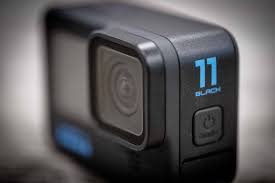What is the best action camera? Is it the GoPro Hero 11 or the DJI Action 2 camera or the Insta360 One RS? There are a dizzying number of action cameras on the market today. Why so many? There are lots of circumstances that call for a camera that can survive bumps, drops, dunks and various harsh conditions.
For such situations, an action camera is a must. While your phone or a digital camera may fail you in tough conditions, an action camera will survive the most extreme situations. GoPro is the best known and established action camera but there are some other names to consider.

With advances from DJI and Insta360 camera companies the competition from rivals of GoPro grows daily. Is there a clear winner among these 3 top players? Not really! Each camera does well overall, and each has strengths over the others. Its better to think about which camera is right for your specific needs as opposed to which camera is just plain ‘the best’.
I have been taking action camera footage on backpacking, surfing and kayak fishing trips for years. Let me use my real life testing of the GoPro Hero 11 Black, DJI Action 2, and Insta360 One RS to help you pick the ideal action camera.
| Camera | Our Rank | Best Price |
|---|---|---|
| GoPro HERO11 | Best Overall |  |
| DJI Action 2 | Close Tie For Second |  |
| Insta360 One RS | Close Tie For Second |  |
Action Camera Considerations
- Usability
- App and connectivity
- Durability
- Versatility
- Portability
Action Camera Usability
To be the best action camera usability is crucial. When you are fighting a fish, racing down a hill or doing some other fast action activity, you need to be able to access the right controls quickly and confidently.
The GoPro Hero comes out the winner in this area. The camera has a large, easy to activate button on the top of the camera. A loud beep will let you know that you actually triggered the camera to take a shot. The other cameras are ok but you may second guess yourself as to whether things have started. That is not a good feeling.
An important part of setting up and maintaining your cameras functionality is the menu. I hate the hassle of complicated menus or having to drill down layers of software functions to get to it. The GoPro has the advantage here with a nice ‘big’ screen and fairly simple interface. The ‘One RS’ is probably the hardest to work with.
Mounting your camera should be easy and secure. The DJI has a unique system using a magnet to secure the camera to several different base mounts. Instead of having to screw the camera on, you just ‘snap’ it on to the base and the magnet holds it in place. Most any metal surface can be used as a base, and they even have a necklace mount.
The GoPro 11 has a retractable mount that is part of the camera. This is simple and makes changing out your camera to different mounts fairly easy.
The ‘One RS’ has the mounting bracket part of the external housing that the camera is inserted into. In this area all three cameras are about equal in ease of use with the DJI having an edge with the magnet mounts.
Connectivity and Apps
Being able to connect to your camera and use remote control functions, manipulate video or upload to the cloud is critical. Software offerings from all these cameras are well made and provide all the functionality one needs. I especially like the the GoPros Quik app that I have installed on my Android phone. I can quickly attach to my camera, control start and stop functions, upload my videos to the cloud and control all my camera settings. Overall, you can’t go wrong with any of these software products.
Durability
All three cameras are very rugged and able to operate underwater or survive serious falls.
As you would expect with a top tier action camera, all three cameras pass in this category. Each is a rugged camera built to withstand falls and tumbles in the field. Each camera is built to get wet and operate under water.
The Hero 11 Black edges the others out due largely to its all-in-one design. I trust it the most in situations where it is likely to come into harm’s way, and it generally seems to be an incredibly rugged piece of workmanship. It is waterproof to 32 ft without Waterproof Case, 196 ft with Waterproof Case.
The DJI Action 2’s core camera module is completely sealed, with no openings in its casing whatsoever, so when used in its most minimal form, it might arguably be said to be tougher than the GoPro.
With a completely sealed configuration when used in its minimal form the DJI Action 2 could be considered a more rugged and dependable camera than the GoPro. But when you start adding on the situation changes. The DJI is waterproof to 32 ft without Waterproof Case, 196 ft with Waterproof Case.
On the other hand, using the Action 2 with the selfie screen module or battery module, your configuration is no longer waterproof at all. You will need the optional diving case to make the camera waterproof with an extra module attached. On a side note the magnets in the Action 2, although convenient, do pick up magnetic particles now and then present in loose dirt, these can be a little difficult to clean out due to the strength of the magnets.
The Insta360 One RS can stand up to rugged use and is waterproof when fully assembled. One warning is that the cover for the USB/microSD ports is not completely dependable, if not correctly sealed or is forgotten, the cameras waterproofness may be compromised. Over all the waterproofness of the camera is a bit confusing. ONE RS is waterproof up to a depth of 5 meters (16.4ft) underwater. If you add the Dive Case, the Dual-Lens 360 Mod is waterproof to a depth of 30 meters (98ft), while the 4K Wide Angle Mod and 1-Inch Wide Angle Mod are waterproof to a depth of 60 meters (196 ft). If you are looking to dive or but under water for much of your activities, you may want to consider the other cameras.
My choice for the most durable of the three action cameras goes to the GoPro. Please be aware that if you use the Volta battery grip and the Media Mod with the GoPro, the setup isn’t waterproof.
Versatility
Having options is a remarkable thing. Action camera companies are trying to differentiate themselves by expanding camera versatility with modular systems and external add-ons to make your camera more powerful than ever. All three of the cameras in this review are doing a fantastic job in this area.
GoPro has been designing external accessories to become more competitive in this area. A standard GoPro really cannot compete with fully modular designs in terms of versatility. For this reason, GoPro as focused on improving in this area. A recent example of this effort is the Creator Edition, which bundles the Hero 11 Black with accessories like the directional microphone called the Media Mod, a battery/control grip called the Volta, and an LED light.
The One RS offers three different lens modules: A standard action camera, a large sensor Leica camera, and a 360 camera. Combining these three cameras creates an impressive array of flexibility as you have different video capture options at your fingertips.
For an outstanding magnetic modular design, the DJI Action 2 really stands out. It features super quick and easy battery swapping. Also, the Action 2 is compatible with the DJI Mic, which is a high-quality wireless mic that can really give you an advantage if audio is important.
All our competitors offer exceptional examples of modularity, each having its own give and takes. I would say its an overall a tie between them in terms of versatility. You just need to decide what fits best with your needs.
Portability
Winning the portability category is the DJI Action 2. As it is fully functional with only its camera module, it is both super small and ultra-light. It’s amazing that a camera of this size can film and record a 4K video at 120fps!
Coming in a little bigger and bulkier is the GoPro Hero 11. It is still quite small though, and if this is an issue I would recommend the Hero 11 Black Bones, being a third of the weight of the standard model. All three side by side, the Insta360 comes in last. It can be quite big and heavy when fully constructed in contrast to the other cameras.

